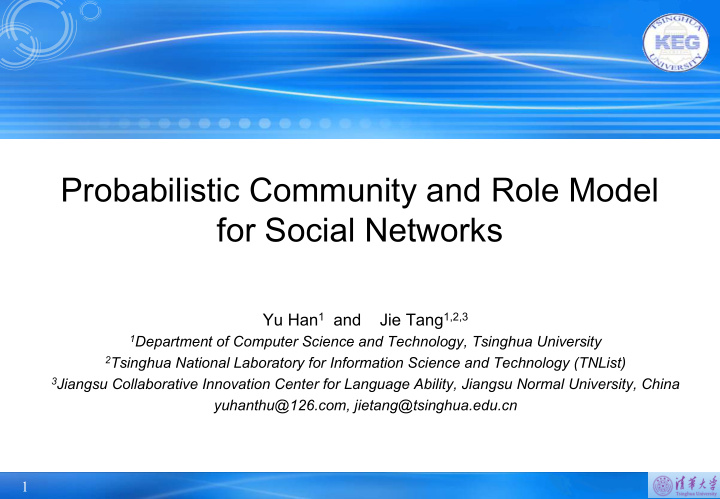



Probabilistic Community and Role Model for Social Networks Yu Han 1 and Jie Tang 1,2,3 1 Department of Computer Science and Technology, Tsinghua University 2 Tsinghua National Laboratory for Information Science and Technology (TNList) 3 Jiangsu Collaborative Innovation Center for Language Ability, Jiangsu Normal University, China yuhanthu@126.com, jietang@tsinghua.edu.cn 1
Social Networks ☺ There are visible and invisible elements in social networks Ø visible elements: users, links, actions Ø invisible elements: communities, roles ☺ Visible and invisible elements interact and affect each other Ø users may have closer relationships within a community than across communities Ø users’ actions depend both on the attributes of themselves and on the influence of their communities Ø … 2
Social Networks This paper is good. Reweet 2nd Tweet Reweet 3rd Reweet Bob 1st John Ellen Jessica Opinion Leader Upload Structural Hole Spanner Commen t Alan Joy I like this photo. 3
Problems: l How should we model a complex social network so that the model can capture the intrinsic relations between all these elements, such as conformity influence, individual attributes, and actions? l How do we use a social network model to handle issues such as community detection and behavior prediction without changing model itself? Limitations of existing work: l Utilizing only portions of the available social network information. l Focusing only on a few aspects of social networks, missing the global view. l Basing on discriminative methods, ignoring the nature of social networks. l Using deterministic method. Can not handle uncertain cases. 4
Our goal: To propose a unified probabilistic framework to model a social network, which can exactly reflect the intrinsic relationships between all visible and invisible elements of a social network, and can be used to handle practical issues in a social network. 5
Intuitions and Assumptions Intuitions Assumptions Assumption 1: Each node ☺ Links. has a distribution over the ü Locally inhomogeneous. communities. ü Each node may belong to several Assumption 2: Each communities. community has a distribution over the links. ☺ Attributions. ü Each node has many attributes, such as Assumption 3: The attributes in-degree, out-degree, etc. of each role satisfy a specific ü Based on these attributes, we can distribution—such as a classify the nodes into clusters. Gaussian distribution. ü Each cluster can be regarded as a role Assumption 4: Each node that nodes play. has a distribution over roles ☺ Actions. according to its attributes . ü Whether a node takes a specific action partly depends on the community it Assumption 5: Community belongs to. and role have a distribution ü Whether a node takes an action may also over actions. depend on the role it plays. 6
CRM Distribution of communities and roles over edges For each node v in the graph: Distribution of γ 1. Draw ζ from Dirichlet( λ ) ; nodes over communities Distribution of nodes 2. Draw a φ v from Dirichlet( β ) prior; over communities 3. For each edge e v,i : l Draw a community z v,i = c from Community Φ multinomial distribution φ v ; ρ Role l Draw an edge e v,i from a multinomial λ distribution ζ (c) specific to community c . For each node v in the graph: 1. Draw a θ v from Dirichlet( α ) prior; ζ µ y 2. Draw a role d v = r from multinomial distribution θ v ; (r) ∼ N( µ r,h , σ r,h 3. For each attribute of v , draw a value x h 2 ). e x For each action y m : H 1. Draw ρ from Dirichlet( γ ) prior; σ 2. Draw a community c v for v from φ v ; 3. Draw a community c u for u , which is the target of the action, from φ u ; Actions 4. Draw a role r from θ v ; Distribution of Attributions 5. Draw y m ∼ Multinomial( ρ τ ,r ). communities over Edges/Links edges 7
Experiments We first use a real dataset to learn the parameters of CRM. Then we use the parameters to generate a synthetic social network. Then we evaluate CRM by the following three tasks: • Structure recovery. We compare the di fg erence of structures between the generated synthetic network and the real network by means of six metrics: degree distribution, cluster coe ffj cient, etc. • Behavior prediction. CRM can predict users’ actions by parameter ρ . • Community detection. CRM can mine communities by parameter ζ . 8
Datasets • Coauthor 1,765 nodes, 13,415 links. • Facebook 4,039 nodes, 88,234 links. • Weibo 1,776,950 nodes, 308,489,739 links. 9
Structural Recovery • Baseline: MAG (UAI’11) • Datasets: • Coauthor • Facebook • Metrics • Degree is the degree of nodes versus the number of corresponding nodes. • Pairs of Nodes is the cumulative number of pairs of nodes that can be reached in ≤ h hops. • Eigenvalues are eigenvalues of the adjacency matrix representing the given network versus their rank. • Eigenvector is the components of the leading eigenvector versus the rank. Clustering Coe ffj cient is the average local clustering coe ffj cient of nodes versus their degree. • • Triangle Participation Ratio is the number of triangles that a node is adjacent to versus the number of nodes. 10
Structural Recovery Metric values of the Coauthor network and the two networks generated by CRM and MAG. CRM outperforms MAG for every metric. 11
Structural Recovery Metric values of the Facebook network and the two networks generated by CRM and MAG. CRM outperforms MAG for every metric. 12
Behavior Prediction • Baseline: SVM, SMO, LR, NB, RBF, C4.5 • Datasets: • Coauthor • Weibo • Metrics: Precision, Recall, F1, AUC 13
Community Detection • Datasets: • Coauthor • Result: 14
Future Work • Mining more factors • Integrating nonparametric methords 15
16
Recommend
More recommend